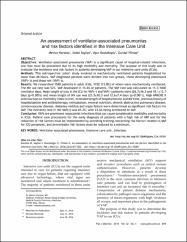| dc.contributor.author | Karataş, Mevlüt | |
| dc.contributor.author | Saylan, Sedat | |
| dc.contributor.author | Kostakoğlu, Uğur | |
| dc.contributor.author | Yılmaz, Gürdal | |
| dc.date.accessioned | 2020-12-19T19:50:43Z | |
| dc.date.available | 2020-12-19T19:50:43Z | |
| dc.date.issued | 2016 | |
| dc.identifier.citation | Karatas, M., Saylan, S., Kostakoglu, U., Yilmaz, G. (2016). An assessment of ventilator-associated pneumonias and risk factors identified in the intensive care unit. Pakistan Journal of Medical Sciences, 32(4), 817-822. https://doi.org/10.12669/pjms.324.10381 | |
| dc.identifier.issn | 1682-024X | |
| dc.identifier.uri | https://doi.org/10.12669/pjms.324.10381 | |
| dc.identifier.uri | https://hdl.handle.net/11436/2462 | |
| dc.description | KOSTAKOGLU, UGUR/0000-0002-4589-0962 | en_US |
| dc.description | WOS: 000383112000005 | en_US |
| dc.description | PubMed: 27648020 | en_US |
| dc.description.abstract | Objectives: Ventilator-associated pneumonia (VAP) is a significant cause of hospital-related infections, one that must be prevented due to its high morbidity and mortality. the purpose of this study was to evaluate the incidence and risk factors in patients developing VAP in our intensive care units (ICUs). Methods: This retrospective cohort study involved in mechanically ventilated patients hospitalized for more than 48 hours. VAP diagnosed patients were divided into two groups, those developing pneumonia (VAP(+)) and those not (VAP(-)). Results: We researched 1560 patients in adult ICUs, 1152 (73.8%) of whom were mechanically ventilated. the MV use rate was 52%. VAP developed in 15.4% of patients. the VAP rate was calculated as 15.7/1000 ventilator days. Mean length of stay in the ICU for VAP(+) and VAP(-) patients were (26.7 +/- 16.3 and 18.1 +/- 12.7 days (p<0.001)) and mean length of MV use was (23.5 +/- 10.3 and 12.6 +/- 7.4 days (p<0.001)). High APACHE II and Charlson co-morbidity index scores, extended length of hospitalization and MV time, previous history of hospitalization and antibiotherapy, reintubation, enteral nutrition, chronic obstructive pulmonary disease, cerebrovascular disease, diabetes mellitus and organ failure were determined as significant risk factors for VAP. the mortality rate in the VAP(+) was 65.2%, with 23.6% being attributed to VAP. Conclusion: VAPs are prominent nosocomial infections that can cause considerable morbidity and mortality in ICUs. Patient care procedures for the early diagnosis of patients with a high risk of VAP and for the reduction of risk factors must be implemented by providing training concerning risk factors related to VAP for ICU personnel, and preventable risk factors must be reduced to a minimum. | en_US |
| dc.language.iso | eng | en_US |
| dc.publisher | Professional Medical Publications | en_US |
| dc.rights | info:eu-repo/semantics/openAccess | en_US |
| dc.subject | Ventilator associated pneumonia | en_US |
| dc.subject | Intensive care unit | en_US |
| dc.subject | Infection | en_US |
| dc.title | An assessment of ventilator-associated pneumonias and risk factors identified in the intensive care unit | en_US |
| dc.type | article | en_US |
| dc.contributor.department | RTEÜ, Tıp Fakültesi, Dahili Tıp Bilimleri Bölümü | en_US |
| dc.contributor.institutionauthor | Karataş, Mevlüt | |
| dc.contributor.institutionauthor | Kostakoğlu, Uğur | |
| dc.identifier.doi | 10.12669/pjms.324.10381 | |
| dc.identifier.volume | 32 | en_US |
| dc.identifier.issue | 4 | en_US |
| dc.identifier.startpage | 817 | en_US |
| dc.identifier.endpage | 822 | en_US |
| dc.ri.edit | oa | en_US |
| dc.relation.journal | Pakistan Journal of Medical Sciences | en_US |
| dc.relation.publicationcategory | Makale - Uluslararası Hakemli Dergi - Kurum Öğretim Elemanı | en_US |


















